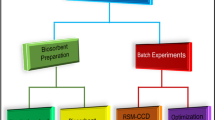Abstract
The potential use of biomass of Aeromonas hydrophila for biosorption of chromium from aqueous solution was investigated. The variables (pH, initial Cr(VI) concentration, biomass dose, and temperature) affecting process were optimized by performing minimum number of experimental runs with the help of central composite design. The results predicted by design were found to be in good agreement (R 2 = 99.1%) with those obtained by performing experiments. Multiple regression analysis shows that uptake decreases with increase in pH and biomass dose, whereas it increases with increase in temperature and concentration. The maximum removal of Cr(VI) predicted by contour and optimization plots was 184.943 mg/g at pH 1.5, initial Cr(VI) concentration 311.97 mg/L, temperature 60 °C, and biomass dose 1.0 g. The removal of Cr(VI) was governed by adsorption of Cr(VI) as well as its reduction into Cr(III), which further gets adsorbed. The sorption capacity of biomass was calculated from experimental data using Langmuir sorption model and was found to be 151.50 mg/g at 40 °C and pH 1.5, which is comparable to other biosorbents. In addition to this, Dubinin–Radushkevich model was applied, and it was found that nature of sorption was chemisorption.







Similar content being viewed by others
References
Volesky, B., & Holan, Z. R. (1995). Biotechnology Progress, 11, 235–250. doi:10.1021/bp00033a001.
Gupta, V. K., Singh, P., & Rahman, N. (2004). Journal of Colloid and Interface Science, 275(2), 398–402. doi:10.1016/j.jcis.2004.02.046.
Volesky, B. (2001). Hydrometallurgy, 59, 203–216. doi:10.1016/S0304-386X(00)00160-2.
Viera, R. H. S. F., & Volesky, B. (2000). International Microbiology, 3, 17–24.
Demirbas, E., Kobya, M., Senturk, E., & Ozkan, T. (2004). Water S.A, 30(4), 533–540.
Gupta, V. K., & Ali, I. (2004). Journal of Colloid and Interface Science, 271, 321–328. doi:10.1016/j.jcis.2003.11.007.
Bishnoi, N. R., Bajaj, M., Sharma, N., & Gupta, A. (2004). Bioresource Technology, 91, 305–307. doi:10.1016/S0960-8524(03)00204-9.
Gupta, V. K., Mohan, D., & Sharma, S. (1998). Separation Science and Technology, 33(9), 1331–1343. doi:10.1080/01496399808544986.
Gupta, V. K., & Rastogi, A. (2008). Journal of Hazardous Materials, 152(1), 407–414. doi:10.1016/j.jhazmat.2007.07.028.
Gupta, V. K., & Rastogi, A. (2008). Journal of Hazardous Materials, in press.
Mohan, D., & Pittman Jr., C. U. (2006). Journal of Hazardous Materials, 137(B), 762–811.
Vijayaraghavan, K., & Yun, Y. S. (2008). Biotechnology Advances, 26, 266–291. doi:10.1016/j.biotechadv.2008.02.002.
Sud, D., Mahajan, G., & Kaur, M. P. (2008). Bioresource Technology, 99, 6017–6027. doi:10.1016/j.biortech.2007.11.064.
Demirbas, A. (2008). Journal of Hazardous Materials, 157, 220–229. doi:10.1016/j.jhazmat.2008.01.024.
Ahluwalia, S. S., & Goyal, D. (2007). Bioresource Technology, 98, 2243–2257. doi:10.1016/j.biortech.2005.12.006.
Gupta, V. K., & Ali, I. (2006). Encyclopedia of surface and colloid science (pp. 149–184, 2nd ed.). New York: Taylor & Francis.
Ali, I., & Gupta, V. K. (2006). Nature Protocols, 1(6), 2661–2667. doi:10.1038/nprot.2006.370.
Miranda, C. D., & Castillo, G. (1998). The Science of the Total Environment, 224, 167–176. doi:10.1016/S0048-9697(98)00354-4.
Loukidou, M. X., Zouboulis, A. I., Karapantsios, T. D., & Matis, K. A. (2004). Colloids and Surfaces A: Physicochemical Engineering Aspects, 242, 93–104. doi:10.1016/j.colsurfa.2004.03.030.
Preetha, B., & Viruthagiri, T. (2007). Journal of Hazardous Materials, 143, 506–510. doi:10.1016/j.jhazmat.2006.09.077.
Ravikumar, K., Ramalingam, S., Krishnan, S., & Balu, K. (2006). Dyes and Pigments, 70, 18–26. doi:10.1016/j.dyepig.2005.02.004.
Box, G. E. P., & Hunter, J. S. (1957). Annals of Mathematical Statistics, 28, 195–241. doi:10.1214/aoms/1177707047.
Park, D., Yun, Y. S., Jo, J. H., & Park, J. M. (2005). Water Research, 39, 533–540. doi:10.1016/j.watres.2004.11.002.
Tan, I. A. W., Ahmad, A. L., & Hameed, B. H. (2008). Chemical Engineering Journal, 137(3), 462–470. doi:10.1016/j.cej.2007.04.031.
Azargohar, R., & Dalai, A. K. (2005). Microporous and Mesoporous Materials, 85, 219–225. doi:10.1016/j.micromeso.2005.06.018.
Kumar, A., Prasad, B., & Mishra, I. M. (2008). Journal of Hazardous Materials, 150(1), 174–182. doi:10.1016/j.jhazmat.2007.09.043.
MINITAB® Release 15 Statistical Software for Windows (2006) Minitab Inc., USA.
Huiping, L., Guoqun, Z., Shanting, N., & Yiguo, L. (2007). Computational Materials Science, 38(3), 561–570. doi:10.1016/j.commatsci.2006.03.014.
Garg, U. K., Kaur, M. P., Garg, V. K., & Sud, D. (2008). Bioresource Technology, 99(5), 1325–1331. doi:10.1016/j.biortech.2007.02.011.
Ravikumar, K., Krishnan, S., Ramalingam, S., & Balu, K. (2007). Dyes and Pigments, 72, 66–74. doi:10.1016/j.dyepig.2005.07.018.
Zulkali, M. M. D., Ahmad, A. L., & Norulakmal, N. H. (2006). Bioresource Technology, 97, 21–25. doi:10.1016/j.biortech.2005.02.007.
Pokhrel, D., & Viraraghvan, T. (2006). Water, Air, and Soil Pollution, 173, 195–208. doi:10.1007/s11270-005-9056-z.
Mor, S., Ravindra, K., & Bishnoi, N. R. (2007). Bioresource Technology, 98, 954–957. doi:10.1016/j.biortech.2006.03.018.
Hasan, S. H., Singh, K. K., Prakash, O., Talat, M., & Ho, Y. S. (2008). Journal of Hazardous Materials, 152, 356–365. doi:10.1016/j.jhazmat.2007.07.006.
Daneshvar, N., Salari, D., & Aber, S. (2002). Journal of Hazardous Materials, 94, 49–61. doi:10.1016/S0304-3894(02)00054-7.
Park, D., Lim, S. R., Yun, Y.-S., & Park, J. M. (2007). Chemosphere, 70(2), 298–305. doi:10.1016/j.chemosphere.2007.06.007.
El-Shafey, E. I. (2005). Water, Air, and Soil Pollution, 163, 81–102. doi:10.1007/s11270-005-8136-4.
Langmuir, I. (1918). Journal of the American Chemical Society, 40, 1361–1368. doi:10.1021/ja02242a004.
Dubinin, M. M., & Radushkevich, L. V. (1947). Proceedings of the Academy of Sciences of the USSR. Chemistry Section, 55, 331–333.
Onyango, M. S., Kojima, Y., Kumar, A., & Kuchar, D. (2006). Separation Science and Technology, 41, 683–704. doi:10.1080/01496390500527019.
Kiran, B., Kaushik, A., & Kaushik, C. P. (2007). Chemical Engineering Journal, 126, 147–153. doi:10.1016/j.cej.2006.09.002.
Acknowledgment
The authors are thankful to Institute of Technology, Banaras Hindu University and University Grant Commission (UGC) (F.No. 32-224/2006 (SR)) for laboratory facilities and financial assistance.
Author information
Authors and Affiliations
Corresponding author
Rights and permissions
About this article
Cite this article
Ranjan, D., Srivastava, P., Talat, M. et al. Biosorption of Cr(VI) from Water Using Biomass of Aeromonas hydrophila: Central Composite Design for Optimization of Process Variables. Appl Biochem Biotechnol 158, 524–539 (2009). https://doi.org/10.1007/s12010-008-8404-z
Received:
Accepted:
Published:
Issue Date:
DOI: https://doi.org/10.1007/s12010-008-8404-z




